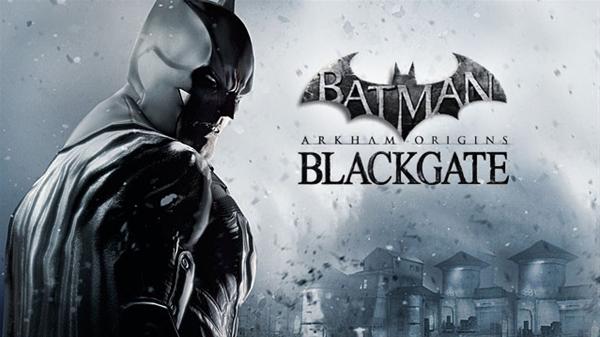Batman Arkham Origins Blackgate Deluxe Edition Review

Batman Arkham Origins Blackgate Deluxe Edition is a port of the handheld spin-off to Batman: Arkham Origins. The title already seems convoluted enough, just as the game itself is, but I’ll get back to it later. The Deluxe Edition offers a few additional features such as enhanced visuals (not much, in truth), but otherwise it’s pretty much the same thing as the Vita/3DS version.
The game is set 3 months after Batman: Arkham Origins, following an uprising in Blackgate Prison after a mysterious explosion which is caused by Joker, Penguin and Black Mask. Each of them takes their turf and now they are holding hostages, which is why Batman ventures to the prison to save them. Batman will have to collaborate with Catwoman in order to bring down the three hardcore criminals and secure all hostages.
There’s no particular order you’ll have to deal them, you can pick your poison right after you complete the brief prologue and open all three main areas: Industry, Cell Blocks and Administration. It should be stressed that environments are samey, each of the three main hubs is seriously lacking in variety except for the Lighthouse which breaks the monotony and repetitiveness a bit, but it’s still too far away from the much desired diversity.
There will be a lot of dull, boxy corridors and sluggish lumbering along.The controls are clunky, with Batman often being clumsy and unresponsive.
As Batman: Arkham Origins: Blackgate is a 2.5D Metroidvania, you’ll encounter a lot of locked doors and obstacles that you’ll be able to overcome only by finding the right gadget (hiding inside WayneTech crates which are scattered around the Blackgate Prison). Gadgets are much like the ones found in the main Arkham games, so you’ll be using Batman’s trustworthy tools such as Line Launcher, Batclaw, Batarang, Gel Launcher, Crypto Sequencer…
By looking around more cautiously, you’ll come across other suit upgrades or you might complete a set of collectables needed for an alternate suit. Finding the right gadget means backtracking, which unfortunately constitutes a huge chunk of the game (which, overall, should take you around 5 or 6 hours to be completed). Backtracking became especially apparent in the very end; it was tiresome and gave me the feeling that developers were just artificially trying to stretch the length of the game.
Platforming is somewhat obscure, which cannot happen to a Metroidvania. It mostly comes down to constant grappling and crawling through vents, with occasional gliding and use of Line Launcher.
I mentioned the game being convoluted. I wasn’t referring to the story (which is very straight-forward and uninteresting), the problem lies in poor level design. It’s confusing and often irritating, and the perplexing isometric map doesn’t help either. The need for constantly opening and closing the map just that you don’t miss some well hidden passage needed for story progression is distracting. The game seriously needed a basic mini-map. You’ll be spending time in detective mode a lot as some solutions (for example, floors destroyable with Gel Launcher) appear only when you go over them (and analyze them) with detective mode’s magnifier.
Graphically, it’s obvious from which platforms the game was ported. The game tried to retain the realistic tone of the main games, but that kind of approach hurt its visual presentation. Blackgate could have been better off with cell-shaded technique. This time, the story is told in comic-like cut-scenes, similarly to inFAMOUS games. Although I always liked that approach in storytelling, Blackgate underdelivers even here as every cut-scene seems static and lifeless. Someone with a keen eye for detail will also notice pixelization present in the cut-scenes.
One thing they got right is combat. Free-flow combat from “big” Arkham games has been slightly altered, but it’s still the recognizable trademark of the series. It’s a lot of fun to fight through the horde of enemies, countering at the right time and continuing your combo.
Stealth, another Batman’s trademark, is obviously here as well, even if a little less prominent. It’s still as satisfying as in other Arkham games, anyway: you’ll be stalking and stealthily taking out your enemies, hiding from their line of vision. By carefully swinging from one grapple point to another, you’ll be able to pick off enemy guards one by one.
Considering how surprisingly well combat is done, it’s a shame we didn’t get to experience it more in the game.
Hacking is actually interesting, and I’d say I had more fun cracking the codes in Blackgate than in other Arkham games. You need to line three right digits in a sequence with your Crypto Sequencer by slowly moving your “pointer”. Few variations of how the hacking works manage to keep it from becoming boring.
For what it’s worth, the boss fights are interesting as well. Each one brings something new and asks for a new approach.
Overall though, the game has serious issues with its design which unfortunately affect the other elements as well; considering this is a Metroidvania, design should have been of utmost importance. As much as one can be a fan of Batman, it’s probably better to either wait for Rocksteady’s Arkham Knight, or just pick up last year’s Batman: Arkham Origins, which was really good according to our review.
